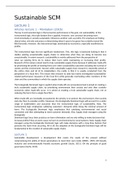Samenvatting
Summary All lectures, articles, tutorials of Sustainable Supply Chain Management. All you need to pass the exam!
- Instelling
- Tilburg University (UVT)
All lectures, articles, tutorials of Sustainable Supply Chain Management. All you need to pass the exam!
[Meer zien]




